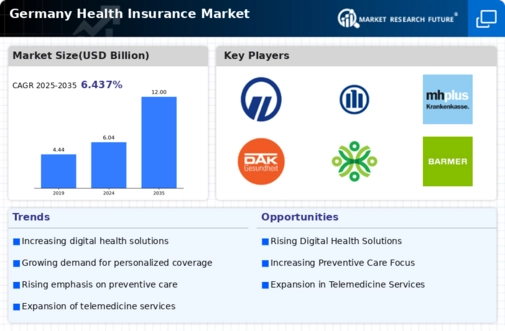The health insurance market in Germany is characterized by a competitive landscape that is increasingly shaped by innovation, digital transformation, and strategic partnerships. Key players such as Allianz (DE), Cigna (US), and AXA (FR) are actively redefining their operational focus to enhance customer engagement and streamline service delivery. Allianz (DE), for instance, has been investing heavily in digital health solutions, aiming to integrate telemedicine and health management apps into their offerings. This strategic positioning not only enhances customer experience but also aligns with the growing demand for accessible healthcare services. Similarly, Cigna (US) has been focusing on expanding its footprint in Germany through partnerships with local healthcare providers, thereby enhancing its service portfolio and market reach.
The business tactics employed by these companies reflect a moderately fragmented market structure, where localized strategies and supply chain optimization play crucial roles. Companies are increasingly localizing their services to cater to the unique needs of the German population, which may involve tailoring insurance products to meet specific regional health concerns. This localized approach, combined with the collective influence of major players, fosters a competitive environment that encourages innovation and responsiveness to market demands.
In October 2025, Allianz (DE) announced a strategic partnership with a leading telehealth provider to enhance its digital health services. This move is significant as it not only expands Allianz's service offerings but also positions the company as a frontrunner in the digital health space, potentially attracting a younger demographic that values convenience and accessibility in healthcare. Furthermore, this partnership may lead to improved health outcomes for customers, thereby reinforcing Allianz's market position.
In September 2025, Cigna (US) launched a new health insurance product tailored specifically for small and medium-sized enterprises (SMEs) in Germany. This initiative appears to be a strategic response to the growing demand for flexible and affordable health insurance solutions among SMEs. By addressing this market segment, Cigna (US) is likely to enhance its competitive edge and capture a larger share of the market, which is crucial in a landscape where SMEs are increasingly seeking comprehensive health coverage for their employees.
In August 2025, AXA (FR) expanded its digital health platform to include mental health services, reflecting a broader trend towards holistic health coverage. This strategic expansion is indicative of AXA's commitment to addressing the evolving health needs of consumers, particularly in the wake of increasing awareness around mental health issues. By integrating these services, AXA (FR) not only enhances its product offerings but also positions itself as a leader in comprehensive health insurance solutions.
As of November 2025, the competitive trends in the health insurance market are increasingly defined by digitalization, sustainability, and the integration of artificial intelligence (AI) into service delivery. Strategic alliances are becoming more prevalent, as companies recognize the need to collaborate to enhance their technological capabilities and service offerings. The shift from price-based competition to a focus on innovation and technology is evident, suggesting that future competitive differentiation will hinge on the ability to leverage technology for improved customer experiences and operational efficiency.






















Leave a Comment